Civil Rights / Cold War
Silent March Held
The sit-ins and downtown boycott in Nashville continued during the spring of 1960.
Then on April 19, someone drove by Z. Alexander Looby’s house and threw a bomb through the window. The Looby family was asleep in the back bedrooms and wasn’t hurt. Looby was an attorney who had represented the protesters in court.
Although they had seen violence during the sit-ins, the student central committee was shocked by the news. The Looby family could have been seriously hurt or even killed. The students decided to march on the courthouse and confront the mayor about the violence.
Then on April 19, someone drove by Z. Alexander Looby’s house and threw a bomb through the window. The Looby family was asleep in the back bedrooms and wasn’t hurt. Looby was an attorney who had represented the protesters in court.
Although they had seen violence during the sit-ins, the student central committee was shocked by the news. The Looby family could have been seriously hurt or even killed. The students decided to march on the courthouse and confront the mayor about the violence.
The march started on the campus of Tennessee A&I (now TSU) with 2,000 people. By the time they got to the courthouse there were 3,000 to 4,000 people. It was the largest protest march up until that time.
More impressively, the march was made in complete silence. At the courthouse square, Guy Carawan from Highlander School started singing “We Shall Overcome.” The refrain rang across the square: “We are not alone….We are not afraid.”
More impressively, the march was made in complete silence. At the courthouse square, Guy Carawan from Highlander School started singing “We Shall Overcome.” The refrain rang across the square: “We are not alone….We are not afraid.”
Mayor Ben West met the marchers on the courthouse steps. At one point, West and marcher C.T. Vivian were arguing about the movement. Diane Nash interrupted them and asked the mayor to use his office to end racial segregation. The mayor agreed saying he “appealed to all citizens to end discrimination.”
“Do you mean that to include lunch counters?” Nash asked. The mayor said, “yes.” The marchers started cheering, drowning out West’s attempt to qualify his statement that it was “up to the store managers.”
The next morning the local newspaper, the Nashville Tennessean, had the somewhat misleading headline: “Integrate Counters—Mayor.” Business owners, who most of all wanted the boycott and sit-ins to end so they could get their customers back, removed whites only signs.
The Nashville Christian Leadership Council and the students had won. It was their finest hour. The next night Dr. Martin Luther King Jr. came to Fisk University to speak. He told them “No lie can live forever…Walk together, children. Don’t get weary.”
Non-violence workshop leader Jim Lawson paid a price for his involvement. Under the urging of the conservative board of trustees, Vanderbilt University kicked him out of school. However, other schools across the country offered him a place, and he left Nashville to go to Boston University.
Picture Credits:
- Photograph of protesters singing “We Shall Overcome” after the Silent March on the Nashville courthouse in April 1960. Guy Carawan, part of the staff at Highlander Folk School, is playing the guitar. Nashville Public Library, Special Collections Division, Nashville Banner Archives
- Photograph of lawyer Z. Alexander Looby’s house after being bombed. Nashville Public Library, Special Collections Division, Nashville Banner Archives
- Part of the "silent" marchers on the way to the Courthouse to protest the bombing of Z. Alexander Looby's house. Photo by Eldred Reaney, courtesy of The Tennessean
- Photograph of Diane Nash confronting Mayor Ben West on Nashville’s courthouse steps. Nash, a student activist, pressed Mayor West for a solution to the sit-ins. Nashville Public Library, Special Collections Division, Nashville Banner Archives
- Nashville students and residents marched in silence on April 19, 1960 from Tennessee A&I and Fisk University to the courthouse to protest the bombing of Z. Alexander Looby's home that morning. In the front (left to right) are C.T. Vivian, Diane Nash, and Bernard Lafayette. The two men visible in the second row are Curtis Murphy and Rodney Powell. Photo by Jack Corn, courtesy of The Tennessean
- Protesters, many of them divinity school students at Vanderbilt University, picket about the expulsion of fellow student James Lawson, who was kicked out because of his participation in the sit-ins. Courtesy of The Tennessean
- Pop-up photograph of Diane Nash is from the National Archives and Records Administration
- Pop-up photograph of Ben West is from the National Archives and Records Administration
Civil Rights / Cold War >> Civil Rights Movement >> Nashville Sit-Ins >> Silent March Held
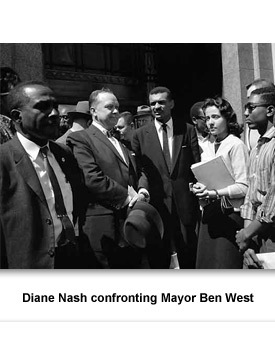
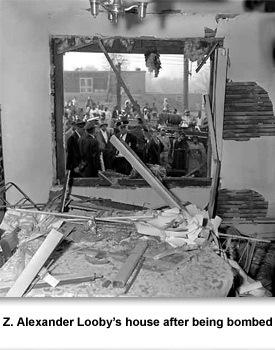
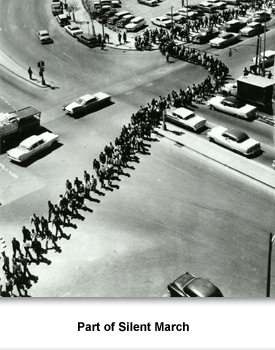
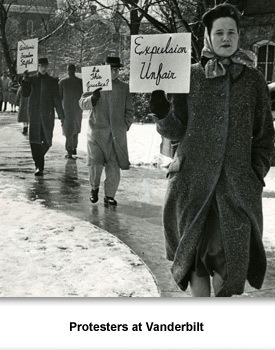
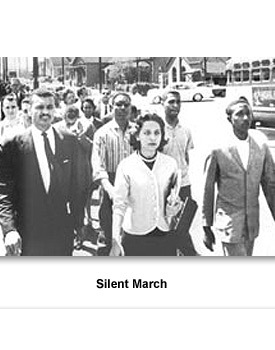
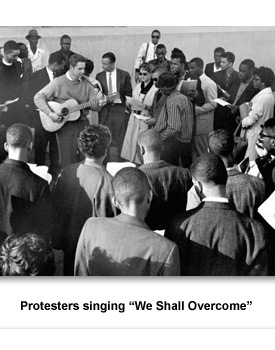
 Sponsored by: National Endowment for the Humanities
Sponsored by: National Endowment for the Humanities